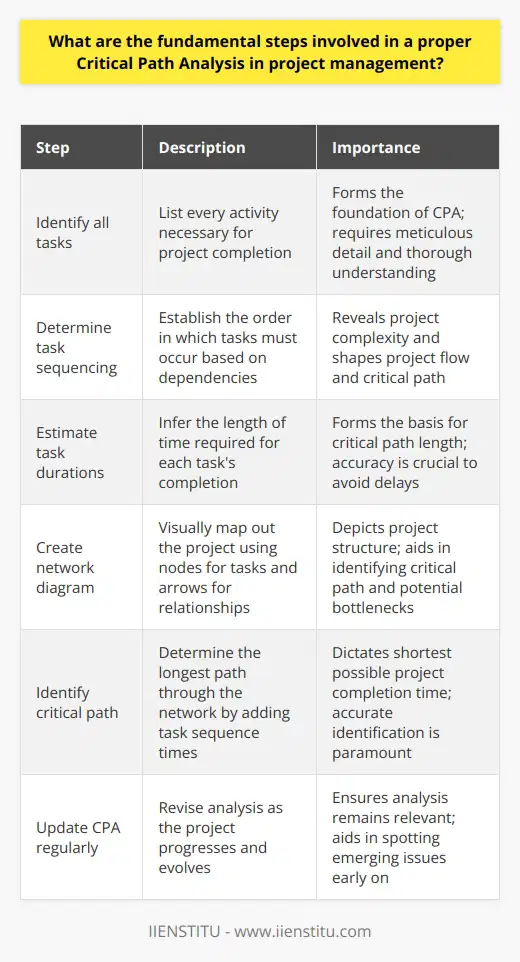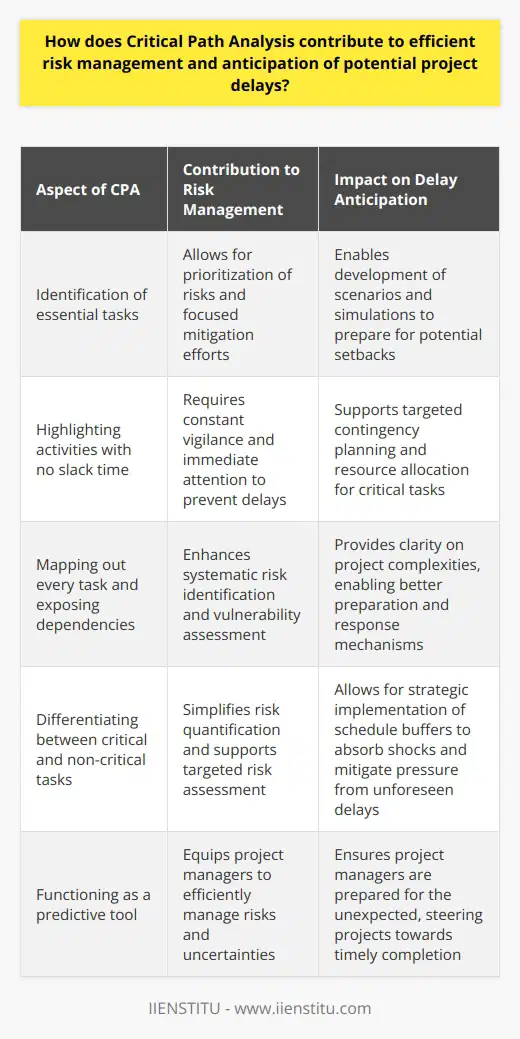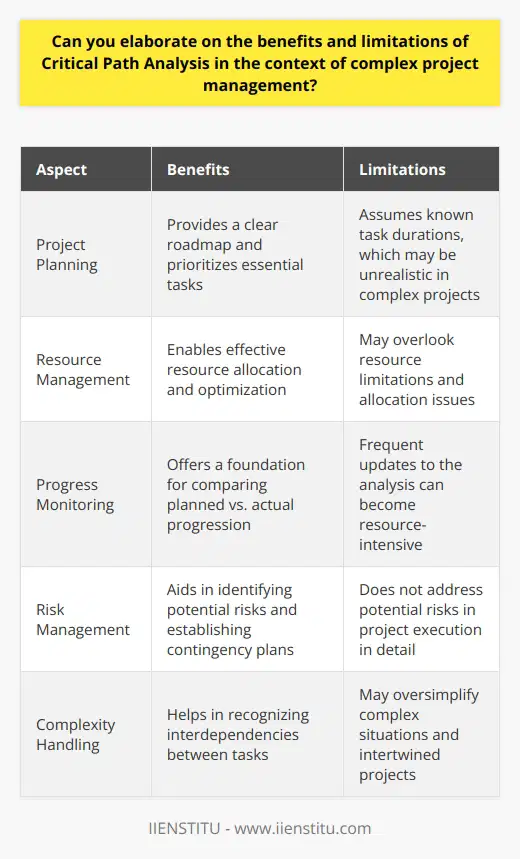
In the intricate matrix of contemporary project management, there exists a cornerstone methodology which benefits managers and teams across various industries—the Critical Path Analysis (CPA). This analytical approach aids in streamlining projects by identifying the sequence of mission-critical tasks which dictate the project's timeframe.
While its roots are anchored deep within the historic advancements of the 1950s, its adaptive nature has allowed it to flourish within the dynamic environment of today's business landscape. Understanding and deploying CPA is no longer a luxury but a fundamental necessity for those aspiring to lead projects to timely and efficient completion.
Understanding Critical Path Analysis
Defining key terms in Critical Path Analysis
Critical Path Analysis crystallizes around several core concepts each pivotal to grasp for unlocking its full potential. At its heart, the Critical Path represents the longest stretch of dependent tasks within a project, determining the shortest possible duration to reach completion. Individual Tasks, the building blocks within this framework, must be meticulously analyzed to understand their scope and impact.
The Project Duration is the amalgamation of time each task within that critical pathway consumes while Predecessors are those tasks that must precede others—forming the skeletal structure that CPA builds upon.
Fundamental principles of Critical Path Analysis
The underpinning principles of CPA revolve around meticulous logistics and timelines. It leverages the immutable logic of sequences and durations, adhering to the idea that any delay in a critical task will invariably extend the project as a whole. Hence, it mandates a systematic process that identifies and monitors these pivotal activities. Recognizing the difference in elasticities among tasks—variable and fixed—is crucial; it not only prioritizes efforts but also buffers against uncertainties.
Detailed look into the Critical Path Method
To truly understand CPA, one must delve into the Critical Path Method (CPM), which involves a granular exploration of workflow. From the identification of key tasks in a project to the estimation of task duration, CPM demands precision and foresight. Constructing a project network diagram becomes a visual enterprise, manifesting abstract plans into a tangible chart. Consequently, the identification of the critical path becomes evident, where each interdependency is mapped, creating a blueprint for the project's temporal boundaries.
The Process of conducting Critical Path Analysis
Step-by-step guide on executing Critical Path Analysis
Executing an effective CPA is a structured endeavor, beginning with an overview of steps that establish a procedural foothold. To describe each step with relevant examples is to shine a light on the path from conceptual planning to practical execution. It is a narrative full of assessments and revisions, with each step beckoning the next, culminating in a comprehensive project trajectory that promotes informed decision-making.
Factors to consider when performing Critical Path Analysis
When embarking on CPA, various factors demand attention—from resource availability to interdepartmental dependencies. It is a matrix that acknowledges the fluidity of the workplace and the volatility that external factors may impose. Here, risk analysis converges with strategic planning to build a resilient and efficient critical path.
Common challenges during Critical Path Analysis and proposed solutions
Common challenges often surface, such as underestimated task durations or overlooked dependencies. These pitfalls have the potential to skew the critical path and threaten the project's timeliness. To counteract these issues, some proposed solutions include rigorous task vetting, acknowledging inherent uncertainties by factoring in buffer times, and utilizing cross-functional oversight to ensure alignment across the project's full spectrum.
Application of Critical Path Analysis in specific settings
Role of Critical Path Analysis in project management
CPA's role in project management transcends mere scheduling—it's a strategic ally that aids in unveiling efficiencies that might otherwise remain hidden. A real-world example of Critical Path Analysis in project management might involve a software development project where feature dependencies dictate the release timeline. By adhering to CPA, the management team can allocate resources more effectively and pace the project towards successful completion.
Use of Critical Path Analysis in the manufacturing industry
In manufacturing, CPA can be the difference between timely delivery and costly delays. It allows for the synchronization of machine maintenance, workforce shifts, and supply chain logistics. A real-world example of Critical Path Analysis in the manufacturing industry might include the production of a new car model where different components must be designed, tested, and assembled in a specific order to meet launch dates.
Application of Critical Path Analysis in construction
The construction industry benefits significantly from CPA by metering out large-scale projects into manageable segments. It aids in planning phases, from groundbreaking to ribbon-cutting, ensuring that materials, labor, and regulatory approvals are orchestrated to prevent bottlenecks. An instance of real-world example of Critical Path Analysis in construction could include a high-rise development that requires a strict sequence of structural engineering, architectural design, and internal fitting before tenants can move in.
Advantages of using Critical Path Analysis
How Critical Path Analysis aids in decision making
CPA serves as an instrumental decision-making compass, offering clarity in the muddy waters of complex projects. It provides the benefit of increased time efficiency by identifying bottlenecks before they occur and suggesting preemptive measures. Consequently, this leads to better resource allocation as the visualization of the critical path sheds light on where human and material capital can be best utilized.
The financial benefits of implementing Critical Path Analysis
Financially, CPA's adoption can lead to notable cost savings. By curtailing project overruns through proactive management, organizations can reduce operational costs associated with delays. This trim in expenditure extends beyond immediate savings, augmenting the financial health of a business in the long term through the ebb and flow of its capital lifecycle.
Improvements in project management due to Critical Path Analysis
Project management as a discipline is refined by the integration of CPA, influencing methodologies that encompass Agile, Waterfall, and Scrum frameworks. The infusion of CPA within these paradigms propels foresight, coordination, and strategic deployment—cornerstones in the art of managing projects.
Limitations and potential pitfalls of Critical Path Analysis
Common misconceptions about Critical Path Analysis
Despite CPA's extensive benefits, misconceptions persist. Some might erroneously view CPA as infallible, whereas in reality, it's a tool subject to the articulations of fluid project dynamics. It is not a set-and-forget application; it necessitates continuous monitoring and adjustment to reflect the real-time state of a project.
Recognition and management of limitations in Critical Path Analysis
Recognizing that CPA is not without limitations enables project managers to use it judiciously. It demands an astute awareness that while CPA charts a path, the journey is often dotted with unforeseen challenges. Acknowledging this, and preparing for it, equips project teams with a resilient mindset, where CPA's guidance is seen as one part of a comprehensive project management toolkit.
Revisiting the quintessential elements of Critical Path Analysis, we re-confirm its indispensability in the modern project management arena. The elucidation of its practicality across various sectors, alongside its advantages and limitations, encapsulates its multi-faceted significance. It behooves professionals and organizations alike to engage with CPA, enhance their operational efficiency, and thereby cement their competitive standing. The journey into the depths of CPA is not just recommended but vital for those seeking to lead with analytical precision and strategic foresight in the project-driven landscapes of business.
Frequently Asked Questions
What are the fundamental steps involved in a proper Critical Path Analysis in project management?
Critical Path Analysis, or CPA, is an essential technique in project management. It helps teams identify the longest stretch of dependent activities. This stretch is crucial to project duration. Understanding its basics ensures effective application.
Identify all tasks required to complete the project
To start with, list each activity necessary for the project. This initial step forms the bedrock of CPA. It requires meticulous detail and thorough understanding. Overlooking even a single task can derail the entire analysis. The integrity of the CPA relies on the exhaustiveness of this list.
Determine the sequencing of these tasks
Next, establish the order in which tasks must occur. Some tasks will depend on the completion of others. These dependencies are vital for scheduling. This step begins to reveal the project's complexity. Interdependencies shape the project's flow and critical path.
Estimate the duration for each task
With the sequence set, you must time each task. This step infers the length of time required for completion. Estimations should be as accurate as possible. They form the basis for the critical path's length. Accuracy in estimation avoids future delays and mishaps.
Create a network diagram
Now, visually map out the project. Use nodes or boxes for the tasks. Connect them with arrows to indicate relationships and flow. This network diagram depicts the project's structure. It allows for easier identification of the critical path. Visually mapping also aids in spotting potential bottlenecks.
Identify the critical path
The crucial step is pinpointing the critical path itself. Add up the time for each sequence of tasks. The longest path through the network is the critical path. This path cannot compress without delaying the project. It dictates the project's shortest possible completion time. Identifying it accurately is paramount.
Update the CPA as the project progresses
Projects are dynamic entities. They change and evolve. Hence, the critical path may shift. Regular updates to the CPA are necessary. They ensure that the analysis remains relevant. Regular updates also aid in spotting emerging issues early on.
To summarize, the following steps form the core of Critical Path Analysis:
Itemize all necessary tasks
Sequence these tasks
Estimate task durations
Diagram the project network
Determine the critical path
Update the CPA regularly
These fundamental steps ensure the identification of the most time-sensitive sequence of tasks. By mastering CPA, project managers can forecast timelines more accurately. They can also manage resources effectively, and enhance their decision-making. CPA is a robust tool in the project management arsenal. Mastery of this method facilitates successful project outcomes.

How does Critical Path Analysis contribute to efficient risk management and anticipation of potential project delays?
Critical Path Analysis and Risk Management
Critical Path Analysis (CPA) stands as a cornerstone in project management. It allows for the identification of essential tasks. These tasks define the project's minimum completion time. By understanding the critical path, managers anticipate potential bottlenecks.
Role of CPA in Risk Management
CPA aids in prioritizing risks. It does so by highlighting key activities. Managers focus on these activities for efficient risk mitigation. Distinctly, CPA underscores activities that possess no slack time. These require constant vigilance. Delays in these tasks impact the entire project timeline.
Risk identification becomes more systematic with CPA. It maps out every task. Dependencies become clear. Interrelationships stand exposed. Managers use this visibility to spot vulnerabilities. They anticipate where things might go awry.
Risk quantification becomes simpler. Managers assess the impact of delays. They study critical tasks. Non-critical tasks offer more leeway. CPA thoroughly differentiates between the two. Such differentiation supports targeted risk assessment.
Enhancing Anticipation of Delays
Insights from CPA bolster delay anticipation. Project managers develop scenarios based on the analysis. They simulate potential setbacks on critical tasks. This forward-looking approach prepares for possible disruptions.
Contingency planning thrives with CPA. Managers create backup plans for critical tasks. They focus resources on these points. This strategic allocation increases agility. It ensures quick responses to delays.
Schedule buffers come into play around the critical path. Managers implement these buffers to absorb shocks. The approach provides breathing room. It mitigates pressure from unforeseen delays.
In essence, Critical Path Analysis equips project managers to manage risks efficiently. It serves as a predictive tool. CPA brings clarity to project complexities. This clarity enables better preparation and response mechanisms. In the dynamic landscape of project management, CPA functions as an indispensable ally. It provides a strong defense against the perils of uncertainty. It ensures project managers are ready. They stand prepared for the unexpected, steering projects towards timely completion.

Can you elaborate on the benefits and limitations of Critical Path Analysis in the context of complex project management?
Benefits of Critical Path Analysis
Critical Path Analysis (CPA) serves as a cornerstone in managing complex projects. It delineates the sequence of pivotal tasks essential for project completion. This methodology affords stakeholders a clear roadmap. It prioritizes activities, highlighting those that directly influence the finish date. CPA also allows the identification of buffer times. These are periods where delays will not affect the project end date.
Project managers leverage CPA for resource optimization. It pinpoints where to allocate resources effectively. This fosters efficient use of time and cost management. In consequence, project costs can reduce through informed planning. CPA aids in recognizing interdependencies between tasks. Such understanding enhances coordination among teams.
Furthermore, CPA offers a foundation for progress monitoring. It enables managers to compare planned versus actual progression. This comparison fosters proactive issue resolution. Managers can establish a baseline against which to measure project performance. Robust planning is a natural outcome of this diligence.
Limitations of Critical Path Analysis
Despite its merits, CPA is not without its drawbacks. Complex projects often involve uncertainties. CPA assumes known durations for tasks, which may be unrealistic. Dynamic project environments can render initial CPA forecasts obsolete. Frequent updates to the analysis can become necessary and resource-intensive.
Another limitation is CPA's focus on task durations. It may overlook resource limitations and allocation issues. If resources are overcommitted, the analysis can be misleading. CPA operates under the presumption that resources will be available as needed. This is not always the case.
Moreover, CPA can sometimes oversimplify complex situations. It does not consider the quality of task completions. Nor does it address potential risks in project execution in detail. It may not adequately capture the complexity of managing multiple, intertwined projects.
Balancing Benefits and Limitations
To make the most of CPA, project managers must remain vigilant. They need to balance its benefits against its limitations. An adaptive approach is paramount. Managers must adjust the critical path as projects evolve. Contingency planning can mitigate some of CPA's limitations. This involves forecasting potential changes and preparing accordingly.
In addition, integrating other project management tools can complement CPA. Risk analysis and quality management methodologies may bridge the gaps. These tools can address CPA's narrow scope on time management alone.
In conclusion, CPA remains a powerful tool within complex project management. It provides structure and direction. However, reliance solely on CPA is not advisable. A blend of foresight, adaptability, and auxiliary tools is crucial. This approach ensures a comprehensive strategy for navigating complex projects.



